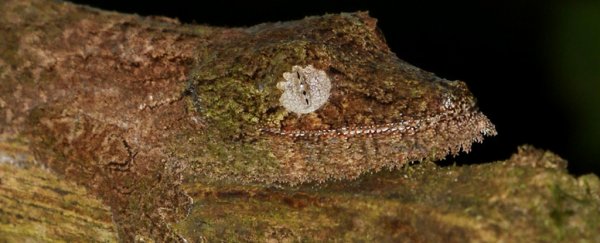When it comes to survival, the denizens of the animal kingdom have a number of different strategies to stay safe. Some creatures use bright colours and get all puffed up to make themselves intimidating. Some disguise themselves as other, more dangerous creatures. And some make themselves invisible.
Not by literally disappearing, of course. But by using camouflage. And one of the most impressive sneaks in the animal kingdom is the Madagascan mossy leaf-tailed gecko (Uroplatus sikorae).
These adorable lizards are sort of speckly and nubbly, with a delicate fringe around their chins and down the sides of their body, and a broad, flat leaf-like tail. They look exactly like tiny wingless dragons that have been snoozing so long that moss and lichen has grown all over their bodies.
 (Joshua S. Ralph/iNaturalist, CC-BY-NC-ND)
(Joshua S. Ralph/iNaturalist, CC-BY-NC-ND)
That's how these nocturnal beasties hide themselves during the day. They flatten themselves against a mossy tree branch, that fringe - called the dermal flap - spreading out around them to reduce the shadows they cast, and look like the edges of lichens.
 (Nina Lester Finlay/iNaturalist, CC-BY-NC)
(Nina Lester Finlay/iNaturalist, CC-BY-NC)
They can alter the colour of their skin to match their surroundings, so unless you were looking really closely, you might never see them.
 (Phil Boyle/iNaturalist, CC-BY-NC)
(Phil Boyle/iNaturalist, CC-BY-NC)
You can see this gecko pretty easily, right? That's probably because its eyes are open - often a dead giveaway - and its chin is on a patch of fluffy green moss that doesn't quite match up to its skin.
 (mschneider/iNaturalist, CC-BY-NC)
(mschneider/iNaturalist, CC-BY-NC)
Now things are starting to get a bit trickier. If you weren't paying attention, or thinking about geckos, this one would just look like a patch of slightly different coloured bark on a mottled branch.
 (JialiangGao/Wikimedia CC-BY-SA)
(JialiangGao/Wikimedia CC-BY-SA)
There are a number of predators that like to eat the mossy leaf-tailed gecko. Birds of prey, such as eagles and owls, as well as rats and snakes, are its primary predators. You'd probably want to hide, too.
 (Michael A. Alcorn/iNaturalist, CC-BY)
(Michael A. Alcorn/iNaturalist, CC-BY)
Only under the cover of darkness does the gecko finally stir, off to hunt its own prey - insects and small invertebrates.
But its biggest threats aren't - of course - the natural predators in the Madagascan food chain. It's us.
Although the gecko's population is currently considered stable, its habitat is diminishing due to human activity and population growth, and it may not remain stable.
In addition, although trade on the species is banned internationally, it is still captured and smuggled around the world at what the WWF referred to as "alarming" rates so people can keep it as an exotic pet.
We hope it gets a lot better at hiding.
